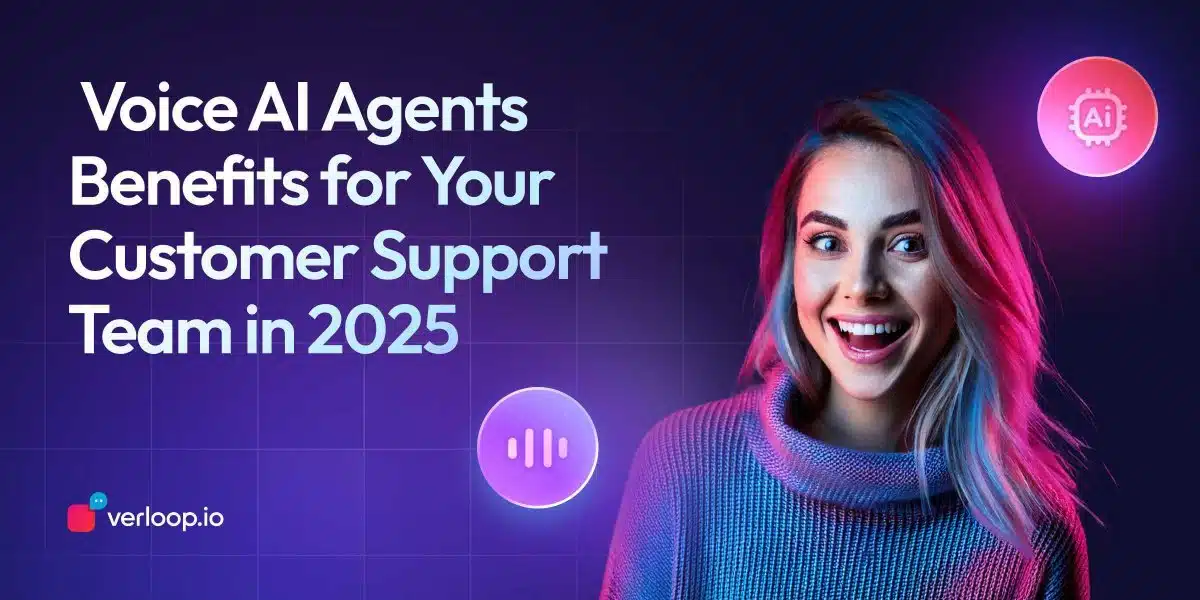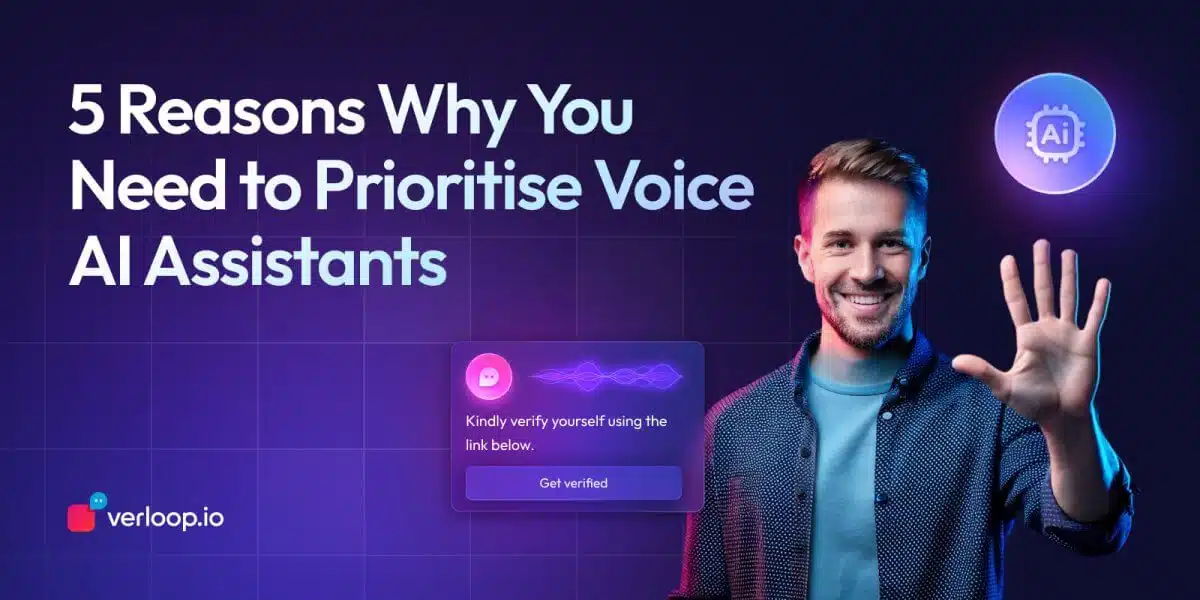Voicebot Benefits for Your Customer Support Team in 2025
- March 6th, 2025 / 4 Mins read
-
Aarti Nair

Voicebot Benefits for Your Customer Support Team in 2025
- March 6th, 2025 / 4 Mins read
-
Aarti Nair
When the market is full of products that offer the same value, businesses need to provide value-added services to stand out from the crowd. Offering excellent assistance in customer support services will win you the competitive business landscape. And this is where your customer experience team sees the voicebot benefits.
Helping customers resolve their queries quickly makes the customer feel delighted and listened to. However, do you know what the average phone wait time is to connect to customer support?
According to BenchmarkPortal, the average call duration across all types of call centres is 5.97 minutes. Moreover, an agent places a phone call on hold for an average of 1 minute and 53 seconds.
Voicebots can reduce these numbers by answering repetitive and generic questions on their own and letting the support staff pick up urgent and complex queries.
Suggested Reading: Why Voice-Based Customer Support is the Future?
Voice AI and Voicebots—A Quick View
Imagine calling your bank’s customer service, expecting to navigate a frustrating IVR menu, only to be greeted by a friendly, human-like voice that instantly understands your query and provides a precise response—without the wait time. That’s the power of Voice AI and Voicebots in action.
What is a Voicebot?
A voicebot is an AI-powered conversational tool that understands spoken language using Natural Language Understanding (NLU) and responds intelligently in real time. Unlike traditional IVR systems that rely on rigid, pre-recorded responses, voicebots leverage machine learning and speech recognition to facilitate seamless, dynamic conversations.
Voicebots can handle various customer needs, from answering FAQs to processing transactions, making them an essential tool for businesses across industries. Their ability to integrate with customer databases enhances personalization, enabling them to recognize customers, recall past interactions, and provide tailored assistance.
What is Voice AI?
Voice AI refers to the underlying technology that powers voicebots. It encompasses advanced algorithms, automatic speech recognition (ASR), and text-to-speech (TTS) technology, allowing machines to understand, interpret, and generate human-like speech.
Unlike traditional chatbots, which rely solely on text input, Voice AI brings a more intuitive, hands-free experience—ideal for situations where customers prefer speaking over typing. This technology is rapidly transforming industries, from customer service and healthcare to banking and retail.
Imagine you’ve just landed at an international airport, tired and jet-lagged. You need to check into your hotel but realize you forgot to confirm your reservation. Instead of scrolling through emails or waiting on hold with customer service, you simply call the hotel’s support number.
Within seconds, a voicebot powered by Voice AI answers:
💬 “Hello, [Your Name]! I see you have a reservation at our downtown hotel. Would you like to confirm your check-in time now?”
You respond, “Yes, I’ll arrive in 30 minutes.”
The voicebot instantly updates your reservation and even offers directions to the hotel. No wait times, no human intervention—just a smooth, efficient customer experience.
Voice AI can be leveraged in two primary ways:
- Inbound Voice AI
- Outbound Voice AI.
1. Inbound Voice AI Solutions (Handling Customer-Initiated Calls)
Inbound Voice AI focuses on responding to incoming customer queries—automating support for businesses handling high call volumes. Instead of waiting in long queues, customers can interact with an AI-powered voicebot that understands their needs and provides real-time assistance.
Example Use Case: Telecom Customer Support
A telecom company receives thousands of daily inquiries about data plans, bill payments, and technical issues. Instead of routing customers through IVR menus, an inbound voicebot instantly assists:
Caller: “I need to upgrade my data plan.”
Voicebot: “I see you’re currently on a 10GB plan. Would you like to switch to our 25GB premium plan for $5 extra per month?”
Caller: “Yes, please!”
Voicebot: “Your plan has been upgraded. A confirmation message has been sent to your email. Anything else I can help you with?”
2. Outbound Voice AI Solutions (Proactively Reaching Out to Customers)
Outbound Voice AI solutions are used to initiate calls, reaching customers with reminders, alerts, promotions, or even conducting surveys. These AI-powered systems can interact with thousands of customers simultaneously, automating engagement at scale.
📌 Example Use Case: Automated Appointment Reminders in Healthcare
A hospital uses outbound Voice AI to remind patients of upcoming appointments, reducing no-shows and optimizing scheduling:
📞 Ring, Ring…
Voicebot: “Hello, this is [Hospital Name]. Your appointment with Dr. Smith is scheduled for tomorrow at 10 AM. Please confirm by saying ‘Yes’ or ‘Reschedule’.”
Patient: “Reschedule.”
Voicebot: “Sure! When would you like to reschedule your appointment?”
Voicebot Benefits: Why Adding A Voicebot Should be Your Customer Support Team’s #Priority?
A voicebot enhances customer support by handling high call volumes, automating routine inquiries, and reducing wait times. For example, in insurance, a voicebot can instantly process policy inquiries, claim statuses, and premium payments without human intervention. In banking, it can authenticate users and provide account details, transaction history, or fraud alerts. By integrating with CRM systems, voicebots offer personalized responses, ensuring faster resolution and a seamless customer experience. Whether for inbound queries or proactive outbound communication, voice AI solutions streamline support operations, cut costs, and improve efficiency.
Calling the call centre and listening to the IVR is frustrating. This creates a customer experience on the hostile front that can lead to the loss of the potential client.
However, if you replace the outdated IVR with an AI-powered voicebot, you can flip the CX to a positive one. Adding a voicebot to your customer service efforts offers the following key benefits:
1. Cater to More People Quickly
The number of calls reaching a customer support team is immense, whereas the resources are limited. Adding a voicebot can help divert the common queries to the AI, allowing quick service to a more extensive customer base.
Some use cases of voicebot include intelligent inbound query resolution and routing, automated verification, and appointment booking.
2. Significantly Shorten Wait Times
The long wait period in the customer support queue is one of the primary reasons for customer dissatisfaction. One bad experience can lead to a customer jumping to a competitor’s service. Hence, the business can use a voicebot service to handle multiple queries at a single point in time.
By allowing bots to answer common questions, a company can significantly reduce the call wait time. And with the unified customer profile that it provides, agents can see customers’ historical data and reduce the time taken to resolve complex queries.
3. Be There When They Are with 24×7 Accessibility
Voice-based chatbots offer quicker resolutions as compared to text-based chatbots. But if one thing is common between them, it’s round-the-clock availability. A customer can connect anytime with the voicebot to get answers to their questions. Be it off business hours or when the company is on a holiday break.
Additional reading: What’s the difference between voicebot and chatbot?
4. Don’t Let Your Customers Repeat Themselves
The customer service team is excellent at their job, but remembering every detail related to the customer is impossible. Transferring calls from agent to agent requires you to repeat the question or problem, which is one reason for dissatisfaction.
AI powered conversational voicebots not only share a unified customer profile with customers’ historical data but also carries forward context from one channel to another, providing a true omnichannel support experience.
5. Personalise Individually, Power Up Conversions
Users are giving companies many opportunities to interact with them. But to convert a user to a customer, how you deliver these interactions matters. And the only correct way is to provide a unique personalised interaction.
Using AI technology that integrates with your various tools, you can match the customer’s needs and offer tailor-made resolutions. A good voicebot will integrate with your tools and systems to make this possible.
6. Save Bucks and Hours
The primary aim of the business is to earn profits. With the voicebot service option integrated with the customer support team, businesses can shift the repetitive tasks from teams to bots. This will save time, reduce the chances of error, and increase productivity. It also reduces the need for extra staff during peak periods and minimises the training needs, which is cost-savvy.
For detailed reading, check out: 7 Clever Ways Voice Chatbot Can Reduce Support Costs

Voicebot And Customer Support: Service Quality Approach
To conclude, voicebot service and assistance are one of the most impressive advancements in recent years. Offering users the ability to connect with voicebots and have their issues answered has decreased the pressure on employees and eased the transfer of general and recurrent questions to a rapid resolution model.
As per Campaign Monitor, 74% of the respondents prefer using voice technology for their queries. Several applications in insurance, travel, banking, eCommerce, and real estate use voicebots due to their numerous advantages.
Verloop.io offers conversational and generative AI to help businesses and customer support teams reduce time, cost, and pressure while ensuring effectiveness is maintained as the top priority.
Take a demo from our experts to understand how it can benefit your business.
FAQs on Voicebots in Customer Support
-
How do voicebots improve customer support efficiency?
Voicebots handle high call volumes by automating responses to repetitive queries, reducing wait times, and allowing human agents to focus on complex issues. This increases efficiency while improving customer satisfaction. -
What is the difference between a voicebot and an IVR system?
Unlike traditional IVR systems that rely on pre-recorded menus, voicebots use AI-powered speech recognition and NLU to understand and respond to natural language queries, offering a more intuitive and dynamic customer experience. -
Can a voicebot integrate with existing CRM and business tools?
Yes, voicebots can integrate with CRM systems, ticketing platforms, and databases, allowing them to access customer history, provide personalized responses, and streamline customer interactions. -
What industries benefit the most from voice AI technology?
Industries like banking, insurance, healthcare, telecom, travel, and eCommerce benefit greatly from voicebots, using them for customer inquiries, appointment scheduling, fraud detection, and transaction processing. -
Are voicebots available 24/7 for customer support?
Yes, voicebots provide round-the-clock support, ensuring customers receive assistance anytime, even outside business hours, reducing operational costs and improving accessibility.







